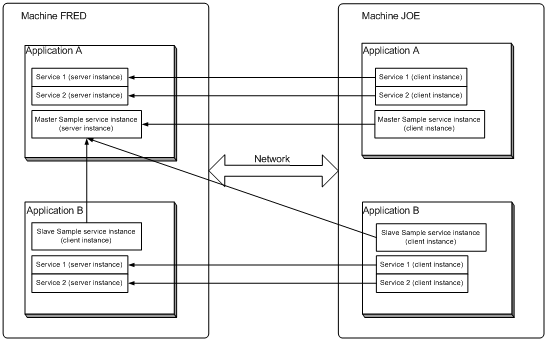Cross-Application Services
While cross-application RPC can be achieved between script applications it is in standard applications that it is most useful. In standard applications, RPCs are performed between services. In cross-application RPC in standard applications, services of the same name in different applications are maintained in synchronization.
One application houses the master service and the other applications house the slave services. The application housing the service with identical RemoteGUID and LocalGUID variables is the master. All other applications house slaves. There can be many different applications housing slaves, but only one application housing the master.
This terminology (master and slave) has been selected to try and avoid confusion between the terms server and client. In cross-application RPC, we define the term "server" consistently with non cross-application services, as being the only service instance that has servership of the service. By definition, this is the master service.
Therefore, exactly one instance of the master service can be a server. All other instances of the master service are clients. All instances of the slave services are clients to the current master service server. This is depicted in the following diagram, where each arrow points to the server instance.

Each application has a service named "Service 1" and a service named "Service 2". These two services are completely independent between the applications, i.e. Application A’s Service 1 has no relationship with Application B’s Service 1. Service Sample, however, is a cross-application service. Application A houses the master service. Application B houses a slave service. Application A on machine FRED is the current server instance of this service. If you were to stop Application A on machine FRED, servership of Application A would transfer to machine JOE (on the assumption that the server list for all Application A services is FRED, followed by JOE). Application B’s Sample service will follow the master service and both application B’s Sample service instances will become clients to Application A’s Sample service on machine JOE.
Note that Application B’s Sample service can not be a server instance, hence the term "slave".
Cross-Application Service Variations - alternative arrangements.
CurSourceAppGUID - for the rare case where the master (or a slave) needs to know which application is making an RPC to it.
